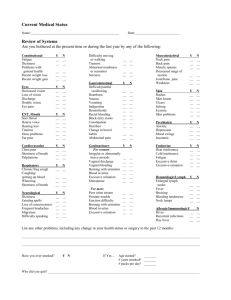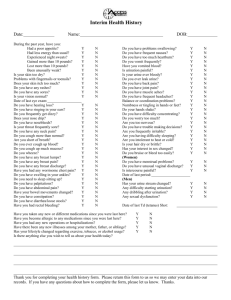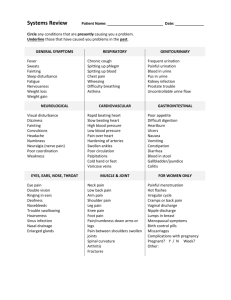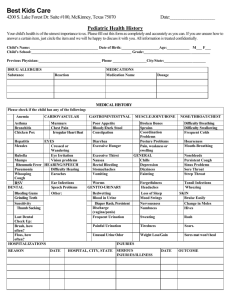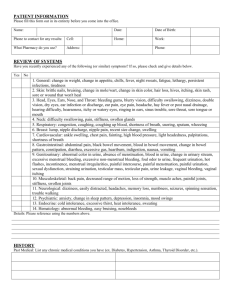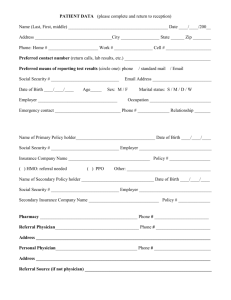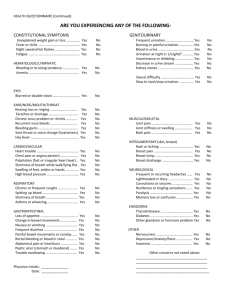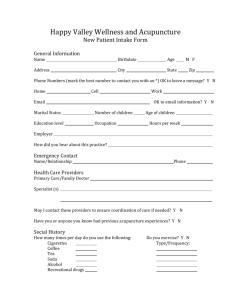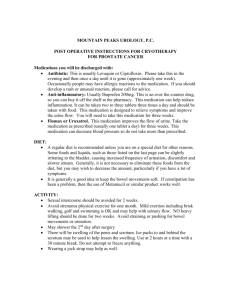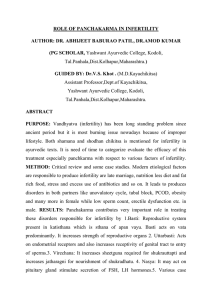Mūtravaha srotas and its diseases
advertisement
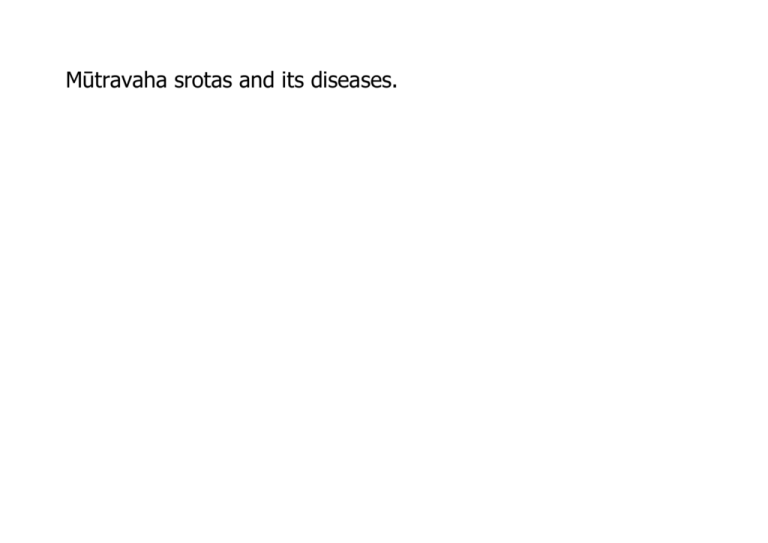
Mūtravaha srotas and its diseases. Srotas Prānavaha Udakavaha Annavaha Rasavaha Raktavaha Maṃsavaha Medavaha Asthivaha Majjāvaha Śukravaha Purīṣavaha Mūtravaha Swedavaha Artava vaha Mūlasthāna (Caraka) Hṛdaya, Mahāsrotas Tālu, Kloma Āmaśaya, Vāma-pārśwa Hṛdaya, Daśa dhamanya Yakṛta, Plīha Snāyu, Twak Vṛkka, Vapā vahan Meda, Jaghana Asthi, Sandhi Vṛṣaṇa, Śefa Pakvaśaya, Guda Basti, Vañkṣaṇa Meda, Romakūpa - Mūlasthāna (Suśṛta) Hṛdaya, Rasavahi dhamanyā Tālu, Kloma Āmāśaya, Annavāhi dhamanyā Hṛdaya, Rasavāhi dhamanyā Yakṛta, Plīha, Rasavāhi dhamanyā Snāyu, Twak, Raktavāhi dhamanyā Kaṭi, Vṛkka Stanau, Vṛśaṇa Pakvaśaya, Guda Basti, Medhra Garbhāśaya, Ārtavavāhi dhamanyā Duṣṭi of mūtravaha srotas leads to disease. Srotoduṣṭi Hetu: vega dhāraṇa of mūtra vega (with-holding of urge to urinate), having food (eating/drinking) when there is the urge to urinate, vyavāya (having sex) when there is the urge to urinate, āghāta (being hit) on basti region (lower abdomen) or medhra (penis) [or vaginal region in the females], other reasons like vraṇa (wounds) on the relevant areas… Lakṣaṇa: excessive or scanty micturation urinating frequently urinating as if urinary passage is blocked continuous dripping of urine (urinary incontinence) sa-śūla/ sa-dāha (painful/ burning) micturation colour, smell, appearance of mūtra being vikṛta (abnormal) etc Cikitsā: Caraka Sutra. 7: Cikitsa should be decided depending on whether the lakṣaṇa are of mūtra-saṅga (scanty urination) or of mūtra-ati-pravṛtti (excessive urination). If there is scanty urination, treatment similar to the treatment of mūtra-kṛcchra should be given. For example, use of snehan and different kinds of swedan in vṛkka and basti regions, nirūha/ anuvāsan/ uttar basti; use of gokṣura, punarnavā, dhamāsa, paṣāṇa-bheda etc. to be used. If there is excessive urination, treatment similar to treatment of prameha should be given. For example, use of tikta, kaṣāya rasa dravya, śilājatu etc. Mūtra-saṅga (Scanty urination) is of 2 types: Mūtra-kṛcchra : urine formation is normal (very little or not affected) but there is blockage of urine, painful urination. Mūtrāghāta : urine formation may be scanty, there may also be blockage of urine, pain is relatively less. Mūtra-kṛcchra: Hetu: Excessive exercise/ physical activity, excessive consumption of tīkṣṇa/ rukṣa dravya, excessive alcohol intake, traveling with speed on horseback (bumpy, fast rides), excessive eating… Samprāpti: Vitiated/ aggravated doṣa finding sthāna saṃśraya (occupying the weak spot) in mūtravaha srotas esp. basti, cause constriction/ contraction of the srotas/ opening of srotas, srotorodha (block of srotas) or kṣobha (irritation) etc. causing pain while urinating. Srotorodha of apāna vāyu causes mūtra saṅga – retention of urine. Purvarūpa: Dark urine, heaviness in basti region, mild pain in basti/ pelvis/ umbilical/ lateral sides of abdomen at urination… Rūpa: General- pain in basti, abdomen, pelvis, sides, even upto hṛday, gaseous distension of abdomen, hṛllāsa (nausea)… Rūpa according to types: Vataj- severe pain in basti and penis/vagina, very scanty urination… Pittaj- dark yellow or reddish urination, painful and burning urination… Kaphaj- heaviness in basti region and penis/vagina, thick/ dense urination… Sannipatik- mix of all above doṣic symptoms… Abhighātaj/ Raktaj- is due to abhighāta/ injury to site of basti or penis… vraṇa (wound) formation, symptoms of vātaj type with bleeding… Puriṣa-vighātaj- Severe constipation (faeces) causes apāna pratiloman, ādhmāna with distension and symptoms of vātaj type… Śukraj- śukra having been expelled from its own sthāna but not out of the penis, becoming avaruddha due to any doṣa esp. vāta, causing blockage of urine and vātaj type… Āśmarij- Mūtra being thickened to solidity by drying action of agni or vāyu, causing formation of aśmari - calculi (stones) or fine powder (sitakā)… this aśmari causing blockage of the mūtra marga, sometimes causing wounds and therefore bleeding etc… Cikitsā: Vātānuloman with snehan (internal/external), swedan, nirūha/anuvāsan/uttar basti, use of mūtral medicines like gokṣura/ gokṣurādi guggulu, punarnavā/ punarnavādi guggulu, dhamāsā, pāṣāṇa-bheda, śilājita, chandraprabhā vaṭi, dhānyak kwātha etc. According to other doṣa involvement, pravāḷa/ mouktika/ kāmadudhā in burning cases, sukṣma triphāla/ gandhak rasāyan in case of wounds/ bleeding etc……. Use of kwātha like arvindāsava, punarnavāsava, varuṇādi kwātha etc. Pathyāpathya: Reducing esp. vātaj hetus, āhāra, vihāra, tomatoes, spinach, excessive sexual activity……. Mūtrāghāta: urine formation may be scanty, there may also be blockage of urine, pain is relatively less. 13 different types of mūtrāghāta are described. After understanding their descriptions, the spectrum of diagnoses ranges from spasmodic stricture, urethral stricture, prostatic enlargement, distended bladder, tumor of the bladder, cystitis, atonia of bladder etc. Some of these are treated with surgery eg. tumor of the bladder, prostatic enlargement (although prostatic enlargement can also be treated by medicines)… It would be wise to try and look at situation in which there is less urine formation. This may be due to problems in the parenchymal tissue of the kidneys characterized by increase in the Blood urea levels or Serum creatinine levels OR in the pakvāśaya which is the site of formation of urine according to Caraka. Rakta meda prasādat vṛkkau – Suśṛta Sārīra Use of vajeri – pakvāśaya of goat. Māṃsa rasa from pakvāśaya of goat has shown amazing clinical results…
